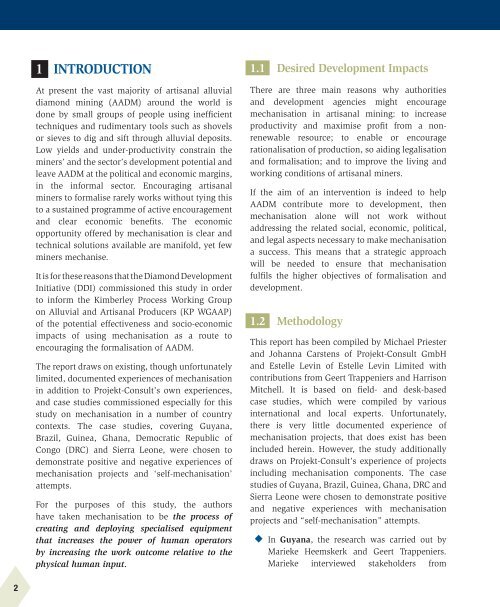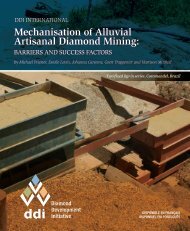Mechanisation-Alluvial-Artisanal-Diamond-Mining
Mechanisation-Alluvial-Artisanal-Diamond-Mining
Mechanisation-Alluvial-Artisanal-Diamond-Mining
You also want an ePaper? Increase the reach of your titles
YUMPU automatically turns print PDFs into web optimized ePapers that Google loves.
1 IntroduCTIon<br />
At present the vast majority of artisanal alluvial<br />
diamond mining (AADM) around the world is<br />
done by small groups of people using inefficient<br />
techniques and rudimentary tools such as shovels<br />
or sieves to dig and sift through alluvial deposits.<br />
Low yields and under-productivity constrain the<br />
miners’ and the sector’s development potential and<br />
leave AADM at the political and economic margins,<br />
in the informal sector. Encouraging artisanal<br />
miners to formalise rarely works without tying this<br />
to a sustained programme of active encouragement<br />
and clear economic benefits. The economic<br />
opportunity offered by mechanisation is clear and<br />
technical solutions available are manifold, yet few<br />
miners mechanise.<br />
It is for these reasons that the <strong>Diamond</strong> Development<br />
Initiative (DDI) commissioned this study in order<br />
to inform the Kimberley Process Working Group<br />
on <strong>Alluvial</strong> and <strong>Artisanal</strong> Producers (KP WGAAP)<br />
of the potential effectiveness and socio-economic<br />
impacts of using mechanisation as a route to<br />
encouraging the formalisation of AADM.<br />
The report draws on existing, though unfortunately<br />
limited, documented experiences of mechanisation<br />
in addition to Projekt-Consult’s own experiences,<br />
and case studies commissioned especially for this<br />
study on mechanisation in a number of country<br />
contexts. The case studies, covering Guyana,<br />
Brazil, Guinea, Ghana, Democratic Republic of<br />
Congo (DRC) and Sierra Leone, were chosen to<br />
demonstrate positive and negative experiences of<br />
mechanisation projects and ‘self-mechanisation’<br />
attempts.<br />
For the purposes of this study, the authors<br />
have taken mechanisation to be the process of<br />
creating and deploying specialised equipment<br />
that increases the power of human operators<br />
by increasing the work outcome relative to the<br />
physical human input.<br />
1.1 Desired Development Impacts<br />
There are three main reasons why authorities<br />
and development agencies might encourage<br />
mechanisation in artisanal mining: to increase<br />
productivity and maximise profit from a nonrenewable<br />
resource; to enable or encourage<br />
rationalisation of production, so aiding legalisation<br />
and formalisation; and to improve the living and<br />
working conditions of artisanal miners.<br />
If the aim of an intervention is indeed to help<br />
AADM contribute more to development, then<br />
mechanisation alone will not work without<br />
addressing the related social, economic, political,<br />
and legal aspects necessary to make mechanisation<br />
a success. This means that a strategic approach<br />
will be needed to ensure that mechanisation<br />
fulfils the higher objectives of formalisation and<br />
development.<br />
1.2 Methodology<br />
This report has been compiled by Michael Priester<br />
and Johanna Carstens of Projekt-Consult GmbH<br />
and Estelle Levin of Estelle Levin Limited with<br />
contributions from Geert Trappeniers and Harrison<br />
Mitchell. It is based on field- and desk-based<br />
case studies, which were compiled by various<br />
international and local experts. Unfortunately,<br />
there is very little documented experience of<br />
mechanisation projects, that does exist has been<br />
included herein. However, the study additionally<br />
draws on Projekt-Consult’s experience of projects<br />
including mechanisation components. The case<br />
studies of Guyana, Brazil, Guinea, Ghana, DRC and<br />
Sierra Leone were chosen to demonstrate positive<br />
and negative experiences with mechanisation<br />
projects and “self-mechanisation” attempts.<br />
◆ ◆ In Guyana, the research was carried out by<br />
Marieke Heemskerk and Geert Trappeniers.<br />
Marieke interviewed stakeholders from<br />
2



